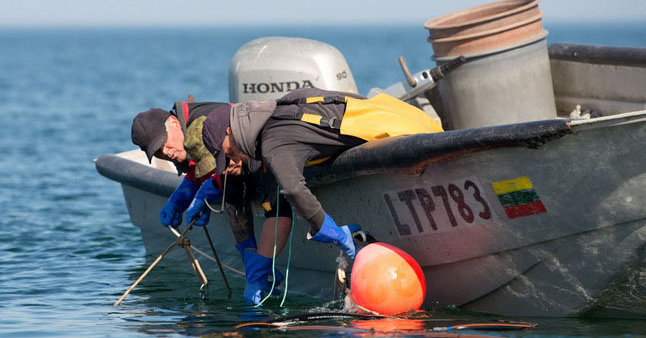
[ad_1]
To see which boats are sailing out to sea by Lithuanian coastal fishermen. You will not see such kamikazes in Scandinavian countries. There all the fishermen have normal boats. Estonians don’t fish on such boats either, only Lithuanians and Latvians still have them. These also put a lot of manual labor into fishing. After navigating such a vessel, the requirement that supervisory authorities have electronic log books on board fishing vessels, which also include those vessels, which must contain catch data and must be completed without leaving the vessel, seems very ridiculous . We sailed to the sea in good weather, the waves, you could say, no. After all, fishermen work in much worse weather conditions.
We sail out to sea from the port of Šventoji, where the depth at a spot between the groynes is 20 centimeters. The boat had to be pushed with a pole. After the Klaipeda State Maritime Port Authority transferred the port of Sventoji to the Municipality of Palanga, we did not notice any significant changes in infrastructure.
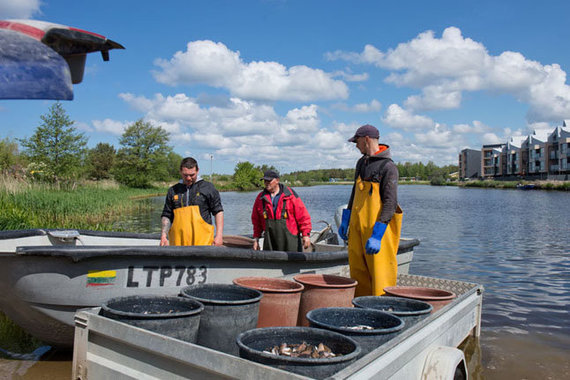
Western Express photo / Two day catch, according to fishermen, quite normal. 90 percent. They sell their catch in Latvia, because there is no one in Lithuania to buy it.
We sailed out to sea to see how the pontoon trap pilot project was being implemented. Because the fishermen themselves would not buy traps for 15 thousand. The project is funded by the Ministry of Agriculture of the European Union Fund for Maritime Affairs and Fisheries. It is hoped that if fishermen are convinced of the usefulness of such traps during the trial period, they can purchase them for their own money in the future.
Coastal fishermen certainly do not have the same impact on fish stocks as our fishing and that of other high seas countries.
When asked if the experiments were being carried out by inertia, if the coastal fishermen were already considering themselves worthy, Robertas Staponkus, a nature conservation specialist at the Lithuanian Nature Fund, replied: “Yes, maybe a Little by inertia, but what you may know is that this is one way to keep this fishing industry going for a while. Coastal fishermen certainly don’t have the same impact on fish stocks as our fishing and that of other offshore countries “
The fight between seals and humans for prey
The Swedes invented pontoon traps to protect the fishermen’s catch from seals. In both Sweden and Finland, they have been captured for a good century, if not more. Because the seal population on the coasts of these countries is very large. According to R. Staponkus, the Swedes and Danes intend to start firing heavily at them this year. Already now, this activity has intensified: the number of dead seals dumped on the coast has tripled. They are feared to increase further with the introduction of intensive hunting.
The great advantage of these pontoon traps is that they protect fishermen’s catch from seals, which not only eat, harm fish, but also break expensive nets.
Traps, nets, lengths from 200 to 300 meters. As the fish sail along the shore, they bounce off that net and try to surround it. If they sail ashore, they successfully avoid the trap, and if they enter
to the sea, some fall into the trap. The seal does not have access to the network due to the tension of the steel cables. According to R. Staponkus, it can get into the net up to a certain place, it can pick up some fish, but it really can’t harm the fishing equipment and all the catch.
The part of the trap that rises above the water and where the fish gather, called the pontoon, is in the air pockets. Fishermen call it caldera. The place marked with a float is simply called a patio.

Western Express Photo / Fishermen preparing: a trap with a catch will immediately rise from the water. Depending on the weather, it takes 2 to 4 people to catch the trap catch.
“The project will be implemented in the fall of this year. We are trying to adapt these traps to our conditions, which are very different from those in Sweden. It is one thing to fish between fjords, where the conditions are favorable for fishing, there is no wind “They are built and maintained there during month two. And one other thing with us on the high seas. Our fishermen need to pull the trap frequently. We have already made some changes and plan to do many more in the fall.”
We want to make a universal tool that allows fishermen to fish throughout the season, which will protect fish from seals and fishermen from by-catches. Incidentally, it is also healthy for birds, as they do not fall into traps, “says R. Staponkus, specialist in nature conservation at the Lithuanian Fund for Nature.
According to him, Lithuanian scientists, in cooperation with partners from Sweden and Germany, want to continue working in this field when this project is completed.
Catch many grundu
According to R. Staponkus, pontoon traps make it easier for fishermen, because when they use a compressor, they themselves rise to the surface of the water. This process eliminates a lot of manual labor, simply because the fishermen themselves no longer have to pull the net. According to the scientist, this is a great boost for young fishermen unfortunately.
One more thing, there are healthier fish in such pontoon traps. Those that are inadvertently caught in nets as by-catches, those that are not of a commercial size or species, are not easily removed from the water and are easily returned to the sea.
According to R. Staponkus, inshore fishermen do a good job, reducing the amount of invasive fish bottoms that are very common in the Baltic Sea. According to him, his fishing has environmental value and also creates added value.
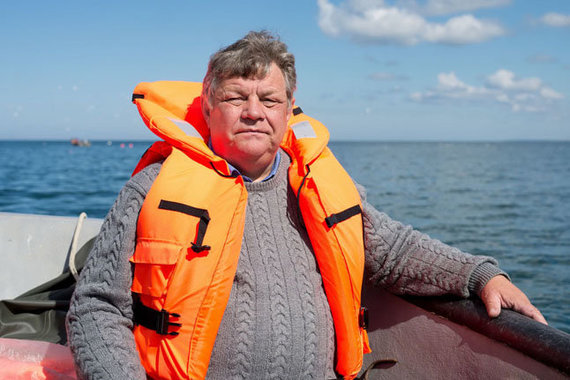
Photo by Western Express / Mindaugas Rimeikis, head of the Association of Coastal and Recreational Fishing Companies, is outraged that the government first orders fishermen to invest and then bans what they have invested.
“The inshore fishing sector is needed just because it traps a lot of ground. Those invading fish have replaced our entire fish food web on the coast. The past few years show that the bottom of our land is shrinking. I think coastal fishermen contributed to that, “says R. Staponkus.
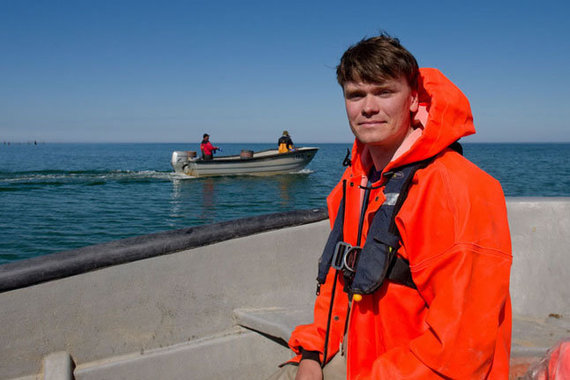
Western Express / Robertas Staponkus photo, a nature conservation specialist at the Lithuanian Nature Fund, says that coastal fishermen do a good job of catching invasive fish: bottom fish.
Šventoji fisherman Gediminas Venckauskis, director of UAB Būtingės žuvis, says such a trap requires less physical labor. “It is very good that science helps fishermen. In that trap, the fish are better maintained because the larger the cavity, the more viable they are. In a word, she is a good thing, said the fisherman. – When we first saw the trap, it seemed big and terrible, quite complicated, but then we got used to it. It is true that it is more suitable for fishing in the fjords, where there are no waves, but I think we will gradually adapt it to our own sea. We have ideas on how we can improve. “
Does not catch cod
“Inshore fishing is still alive and well, although the competitive conditions for its fishermen are really uneven compared to amateur fishermen. Various bans have started. When cod fishing was banned in the eastern Baltic, the European Union also banned fishing of this type for coastal fishermen. We only have 12 tons of by-catch. But now it’s practically impossible to do this when fishing with gillnets, because if I catch 2 starlings and 5 cod, then cod is no longer a by-catch, but the main fish. Therefore, it is practically impossible to build nets, “said Mindaugas Rimeikis, head of the Association of Coastal Fisheries and Coastal Recreation.
According to him, the experimental trap can be built at a depth of no more than 7 meters, and the cod does not reach this depth, so coastal fishermen do not fish for cod.
When cod is banned, fishermen are not allowed to continue fishing at sea. They cannot even reach a depth of 20 meters. Only amateur fishermen can fish there, of course, not cod. Therefore, coastal fishermen only have fish that come close to shore.
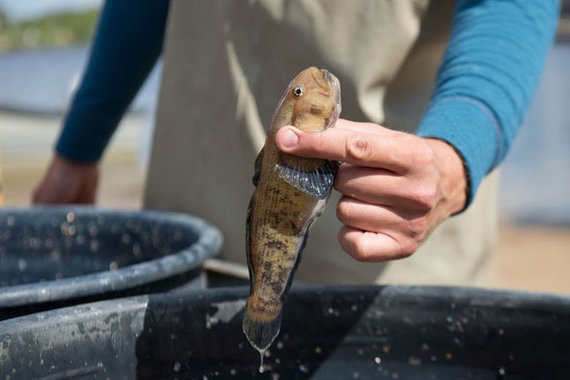
Western Express Photo / Here is a fish so small that it does a lot of damage to our conventional fish.
The sea trap was lowered a good week ago and inspected every few days. The two-day catch (wind fish (they have a long stork beak, by the way, their bones are colored), grundul, sprats) did not seem very abundant.
M. Rimeikis was satisfied with the experimental trap with which the association’s fishermen catch fish in cooperation with scientists, which not only repels seals and fishermen can withdraw all their catch, but also all fish caught as catch secondary are returned to the sea.
I’m not sure if the fishermen next year
There are 9 fishing companies in Šventoji, in total Palanga and Šventoji have 18 companies. A total of 55 companies fish on the coast. According to G.Venckauskis, due to the ban on cod fishing in Šventoji, only 1 of their companies, which use traps, is fishing because there is nothing left to catch.
“The Ministry of Agriculture is passing such laws that it is no longer clear if we will fish next year. The ministry is interested in limiting the number of traps and is preparing new fishing rules. I think the traps are incorrectly divided. The one who does not fish receive, and he who does not fish.
We can not think of any investment, we do not want to try to improve something, improve, because we can run out of business.
We cannot plan anything for the future because we know nothing of what will happen. He won’t ban fishing at all, he just wants to ban cheating. Perhaps the people of the ministry have not seen that fishing, it seems to them that the traps are harmful to nature and the nets are not. They want a boat to have only one trap, when now a boat works with 5 traps and the income is not really high. The minister also promised to speak to the fishermen, but he does not know if he will not do what they see in Vilnius, and that is all. The scientific work is not done at sea, not analyzing the work of the fishermen, but in Vilnius, and then, according to their findings, the fishermen are jumped. We can’t think of any investment, we don’t want to try to improve anything, because we can run out of business, “said fisherman Gediminas.
“The government offers fishermen to make investments, they make them, and then everything is prohibited. The fishermen have bought traps as selective measures and now they want to prohibit them. When you talk face to face with scientists, they tell you that there are enough fish in the coast, “said M. Rimeikis.
The exit is complicated
“And with sailing from the Sventoji port, we have been struggling for at least 30 years. At first, it may have been a little better before the beaches of Palanga began to fill with sand. Now the ever prevailing southern current The sand hangs behind our pier and puts everything in the Santo. Previously, the coast was 2 meters deep 10 meters from the shore, and now the children are 50 meters from the sea. All the stones are covered with sand, we have You could dig it with us and transport it to Palanga, he would come back again “, thinks G. Venckauskis.
Therefore, the fishing boats always have sticks to push the boat if necessary.
“You have seen the port of Sventoji yourself. Do you feel that something is being done? It is already collapsing. When we were children, there was still talk of how to build a port here. We are already aging and it is still being built,” said the fisherman.
[ad_2]